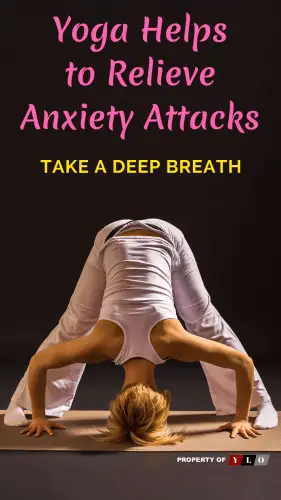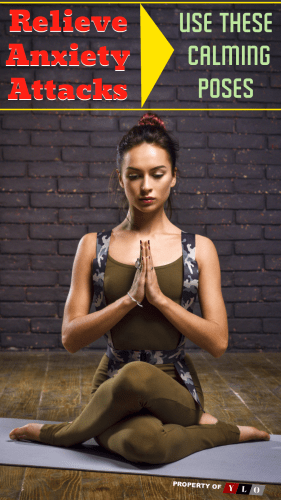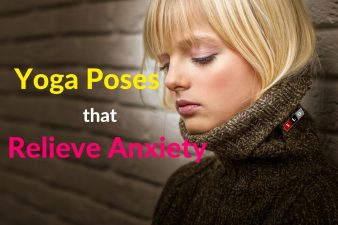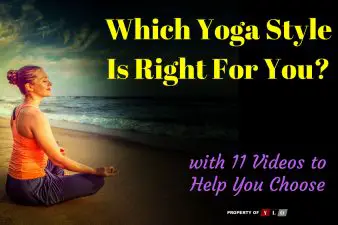There are forms of Yoga that have the ability to Relieve Anxiety Attacks. Living with constant anxiety and stress is bad for our mental and physical health. Anxiety is not always bad. It can be helpful to us in our lives. It is this second sense that at times has saved lives. Anxiety can alert you when a bad situation is at hand or headed your way.
Yoga Helps to Relieve Anxiety Attacks
Over 40 million people suffer from a stress or anxiety disorder in the United States alone and those are the ones who have been diagnosed with it as a chronic illness. Medical help can be important to people suffering from these issues. There are many avenues available to sufferers other than medication. Yoga and Meditation are known to relieve anxiety attacks.
Mediation and controlled breathing, as well as relaxation techniques, can be vital in controlling this illness. Hopefully leading a happy life without the use of medications or in conjunction with them.
Performing a simple set of Yoga exercises when you have the creepy feeling in your stomach from being nervous or anxious can let you calm yourself quickly and efficiently. This is a very soothing way to relieve anxiety attacks.

It Starts With Controlled Breathing
Use calming breathing techniques. They will teach you to put yourself in a place away from anxiety or mild stress. You can find an inner calm that will take you into your happy and/or safe place.
1. Breathing/Savasana Exercises to Relieve Anxiety Attacks
Savasana helps calm the body and relieve stress.
1. Lying on your back, let the arms and legs drop open, with the arms about 45 degrees from the side of your body. Make sure you are warm and comfortable if you need to place blankets under or over your body.
2. Close the eyes, and take slow deep breaths through the nose. Allow your whole body to become soft and heavy, letting it relax into the floor. As the body relaxes, feel the whole body rising and falling with each breath.
3. Scan the body from the toes to the fingers to the crown of the head, looking for tension, tightness and contracted muscles. Consciously release and relax any areas that you find. If you need to, rock or wiggle parts of your body from side to side to encourage further release.
4. Release all control of the breath, the mind, and the body. Let your body move deeper and deeper into a state of total relaxation.
5. Stay in Shavasana for 5 to 15 minutes.
6. To release: slowly deepen the breath, wiggle the fingers and toes, reach the arms over your head and stretch the whole body, exhale bend the knees into the chest and roll over to one side coming into a fetal position. When you are ready, slowly inhale up to a seated position.

2. Warrior 2 Pose to Relieve Anxiety Attacks
1. Stand in Tadasana (Mountain Pose). With an exhalation, step or lightly jump your feet 3 1/2 to 4 feet apart. Raise your arms parallel to the floor and reach them actively out to the sides, shoulder blades wide, palms down.
2. Turn your right foot slightly to the right and your left foot out to the left 90 degrees. Align the left heel with the right heel. Firm your thighs and turn your left thigh outward so that the center of the left knee cap is in line with the center of the left ankle.
3. Exhale and bend your left knee over the left ankle, so that the shin is perpendicular to the floor. If possible, bring the left thigh parallel to the floor. Anchor this movement of the left knee by strengthening the right leg and pressing the outer right heel firmly to the floor.
4. Stretch the arms away from the space between the shoulder blades, parallel to the floor. Don’t lean the torso over the left thigh: Keep the sides of the torso equally long and the shoulders directly over the pelvis. Press the tailbone slightly toward the pubis. Turn the head to the left and look out over the fingers.
5. Stay for 30 seconds to 1 minute. Inhale to come up. Reverse the feet and repeat for the same length of time to the left.
3. Seated Forward Fold to Relieve Anxiety Attacks
1. From Staff pose, inhale the arms up over the head and lift and lengthen up through the fingers and crown of the head.
2. Exhale and hinge at the hips, slowly lower the torso towards the legs. Reach the hands to the toes, feet or ankles.
3. To deepen the stretch: A) Use the arms to gently pull the head and torso closer to the legs. B) Press out through the heels and gently draw the toes towards you.
4. Breathe and hold for 3-8 breaths.
5. To release:
– A) Slowly roll up the spine back into Staff pose.
– B) Inhale the arms back over your head as you lift the torso back into Staff pose.

4. Childs Pose Is Perfect To Relieve Anxiety Attacks
1. Begin on your hands and knees. Center your breath, and begin to let your thoughts slow down. Turn your awareness inward.
Spread your knees wide apart while keeping your big toes touching. Rest your buttocks on your heels.
2. Those with very tight hips can keep their knees and thighs together.
3. Sit up straight and lengthen your spine up through the crown of your head.
4. On an exhalation, bow forward, draping your torso between your thighs. Your heart and chest should rest between or on top of your thighs. Allow your forehead to come to the floor.
5. Keep your arms long and extended, palms facing down. Press back slightly with your hands to keep your buttocks in contact with your heels. Lengthen from your hips to your armpits, and then extend even further through your fingertips.
— For deeper relaxation, bring your arms back to rest alongside your thighs with your palms facing up. Completely relax your elbows.
6. Let your upper back broaden. Soften and relax your lower back. Allow all tension in your shoulders, arms, and neck to drain away. Keep your gaze drawn inward with your eyes closed.
7. Hold for up to a minute or longer, breathing softly.
A helpful article by WebMD: Surrender to Yoga



